Beamish - The North of England
Open Air Museum
Beamish, Co Durham
| Beamish, The North of England Open Air Museum is an open air museum
opening to the public in 1972. It's guiding
principle is to show what life was like in urbanised North East England at the
climax of industrialisation in the early 20th century, much of the
restoration and interpretation is specific to 1913, together with portions of
countryside under influence of the Industrial Revolution in 1825. It covers 300
acre and uses a mixture of translocated, original and replica buildings, a huge
collection of artefacts, working vehicles and equipment, costumed interpreters,
and livestock to show what life was like during this time. The first buildings
to have been erected on the site were the railways station and colliery winding
engine. |
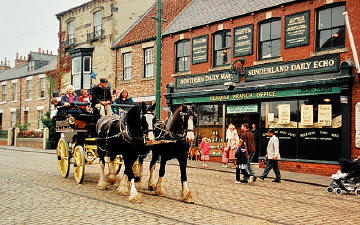 |
| The site is made up of 5 main regions linked by a system of trams
which goes round the whole site and replica
buses and cars. It is a 20 minute walk from the entrance to the town, and 20
minutes from Pockerley Manor. If you were to walk the site in a clockwise
direction you will get the areas in the following order: Home Farm is a model estate farm and illustrates farm life in 1913. It has:
- a
farm cottage where you can see how the farmers wife spent her day in the
farmhouse kitchen
- a long cart shed and blacksmiths forge
- a 'gin gan' horse powered engine and a
steam-powered threshing mill.
- a 2 storey
building called a 'poultiggery' by staff as it houses chickens upstairs and
pigs downstairs.
Animals you may see on the farm either in the
fields or buildings include Shorthorn Cattle,
Saddleback pigs, Teeswater sheep and a range of geese, ducks and farmyard
poultry and three breeds of heavy and half heavy horses which are used for
industrial and agricultural work around the museum.
|
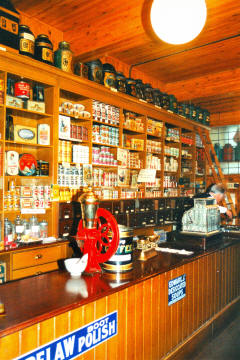
 For all images on this page
For all images on this page
Click
on images to see larger version |
| The Colliery Village around 1913. Coal mining had a major impact on
this region of England and Beamish exhibits a number of buildings and artefacts
to demonstrate this. These include: |
- a coal mine originally opened in the
1850's and was closed in 1958. Here you can take an underground tour of the
Mahogany Drift Mine which is an original feature of the site.
Hard hats are provided.
- the regularly-steamed 1855 vertical
winding engine, screens, and waste tip
- Pit buildings
- Engine shed
- Powder House
- a number of chauldron wagons
(the regionís traditional type of colliery railway rolling stock, which
became a symbol of Beamish)
- There is usually a pit pony on site.
The surrounding village includes:
miners' cottages and
their backyards
a Wesleyan Methodist
chapel
East Stanley Board
School where you can have a go with a booler ( a ringed hoop with a rod
attached) made at the onsite Blacksmiths forge.
Making our way onto the town you get to the
traditional fairground, the centrepiece being the traditional "Galloper", there
is also a coconut shy, hall of mirrors and Shuggy Swing Boats as well as wooden
Helter-Skelter. The cost of the rides on the fairground are not included in the
entry fee. |
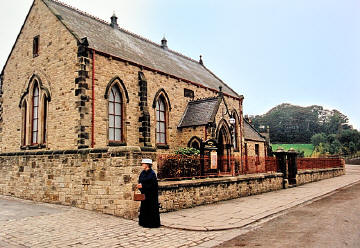
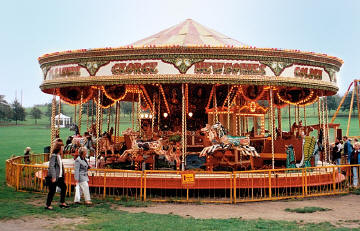 |
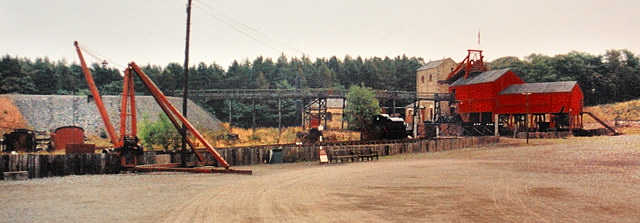

The Town - a recreation of Victorian buildings around 1913
and here staff recreate the history dressed in costume carrying out the
activities of the day. The
buildings you will find amongst it are:
- Annfield Plain Co-Operative Store (with operating cash carrier system)
- a terrace of professionalsí houses, occupied by a music teacher,
dentist's surgery and family home, and solicitorís office
- the Sun Inn public house
- town livery stables and carriage house housing an extensive collection of
horse-drawn vehicles;
- a branch office of the Sunderland Daily Echo
- a stationerís and printshop
- a sweet shop and factory -
see here
for traditional sweets you can buy online

- a motor and cycle works
- a branch of Barclays Bank
- a Masonic Hall - telling the history of
Freemasonary in the North East in 1913.
|
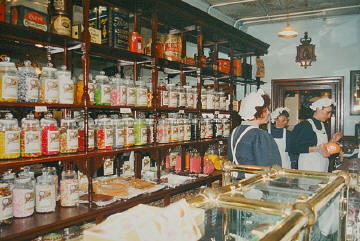
 In the Sweet Shop
In the Sweet Shop
Click
on image to see larger version |
| There is a bandstand in a town park, together with drinking fountains and
other examples of street furniture. The Railway Station is a typical North Eastern Railway station on the
edge of town, and it recreates a typical branch line country station. It has a:-
- passenger building dating from 1867 with a ticket office and a
ladies only waiting room
- signal box
- weighbridge house
- goods shed
- Coal Cells
Within the station area there is also a variety
of rolling stock including coal wagons and an NER Class C060 tender loco, but
they are not usually in steam at the station.
|
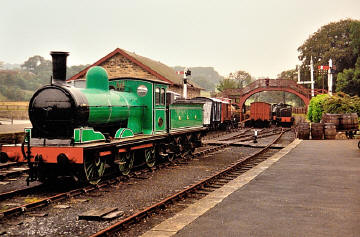
 At the station
At the station
Click
on image to see larger version |
Pockerley Manor 1825. There have been
people living at Pockerley for over 1000 years and was an original part of this
site. The small Manor House today represents what it would have looked and felt
like in the early 1800's when occupied by a yeoman landowner with his family,
servants and labourers. Also in this area is:
- The Old House - which would originally
have form a strong-house wing of an earlier larger manor. It is lit by
candle light and you may get to see candle making on your visit.
- Manor Gardens - contain a formal garden,
cultivated vegetable plots and orchards.
- The Horse Yard and stables - During the 1800's
horses were an integral part of life being used to
work on the land, as pack animals and to pull carriages, gigs and carts.
They have Clydesdale Heavy Horses here, but they also breed Cleveland Bay
Horses, now a rare breed.
Pockerley Waggonway of 1825. Here you
get to ride in replica carriages behind The Steam Elephant (a replica of George
Stephenson's Locomotion No. 1, the first public passenger carrying steam train.
But also in this area you can see:
- A period Running Shed
- The Engineers Drawing Office
- Engine Drivers' bothy.
|
Transport
The museum contains as variety of transport and they make use of much of it
to get visitors around this large site.
The Tramway fulfils a dual function, a
transport system which links the whole of the site from the entrance and also
gives visitors the chance to experience an authentic tram ride. The tramway is
one and a half miles long with stops at the Town and near the other main areas
running every 20 minutes.
Replica Bus. During the summer season you can
also take a ride on a replica bus from The Town to the Colliery Village. The bus
is a copy of a double-deck bus owned by Gateshead Tramways in 1913.
Horse-drawn buses and charabancs were once a
common site and during the summer seas you can often ride over part of the site
in one of two charabancs the museum has.
|
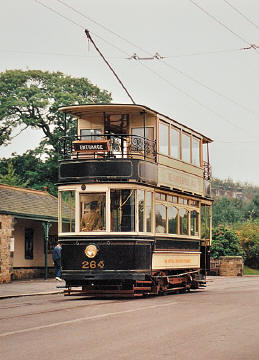
 |
Click
on images to see larger versions
 Different forms of Transport that can be found at Beamish
Different forms of Transport that can be found at Beamish
|
Other Activities
As well as all this there
are also demonstrations taking place during the summer season, these might
include:
- Steaming in the Station
- Brass Band concerts in the Town Park
bandstand
- Chapel Choirs in the Colliery Village
Chapel
- Harness Making in the carriage house in
the Town
- Lace Making in the Town
- Concertina Player in Home Farm Kitchen
- Basket Making at Home Farm
- Corn Dollies at Pockerley Manor and Home
Farm
|
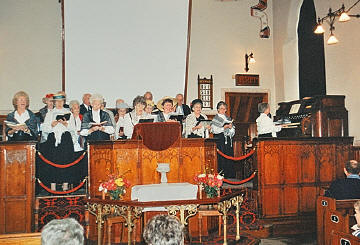 |
|
|
 Click on image to see larger version
Click on image to see larger version
|
There are also lots of events running most of
the time from April through to end of October see their website
Special events
page
 for
details. for
details.
.
Planning Grid
|
Location: |
The North of England
Open Air Museum, Beamish, Co Durham |
|
Grid Reference: |
NZ219541 |
|
Getting there: |
12 miles north west of historic Durham City
and 8 miles south west of Newcastle upon Tyne. From A1M J63 follow the
tourist signs. |
|
Access: |
Once inside they run a regular Tramway and Bus
service around the site. The last tram from the town back to the entrance is
5pm. |
|
Parking: |
Free large car park on site. Car Park for
people with disabilities |
|
Facilities: |
Souvenir Shops, Picnic areas, Toilets in most
areas, 4 eateries with at least one being open during the winter period. |
|
Things To Do,
See and Photograph: |
Lots of things to photograph |
|
What to take: |
|
|
Nature highlights: |
Farm animals, horses and some visiting
wildlife |
|
Address: |
Beamish Museum
Beamish
County Durham |
|
Postcode: |
DH9 0RG |
|
Telephone: |
0191 370 4000 |
|
Opening times: |
Summer Season 2008
15th Mar-2nd Nov Daily 10am to
5pm, last admission 3pm
Winter Season 2008/2009
3rd Nov-3rd Apr 2009 10am
to 4pm, last admission 3pm
Closed Mon and
Fri. Closed 8th Dec-2nd Jan 2009 inclusive.
A winter visit is
centred on The Town and tramway only. Other areas of the Museum are closed
and admission charges are reduced. |
|
Charges: |
Summer: Adult £16; 60+ £13; Child (5-16yrs)
£10; Family (2+2) £46
Winter: Adult £6; 60+ £6; Child (5-16yrs) £6.
Also have annual passes
see
this link for details.
Fairground rides not included in entrance fee
and costs £1.20 a ticket |
|
Photo Restrictions: |
|
|
Other Restrictions: |
|
|
Special Needs Access: |
steps into many period buildings. Drift mine
is not accessible to wheelchair users |
|
Special Needs Facilities: |
Wheelchair accessible toilets in most areas.
Have photographic files available for visitors unable to view the actual
building inside. |
|
Children Facilities: |
Baby Changing Facilities |
|
Dogs Allowed: |
Must be kept on lead. Only guide dogs and
hearing dogs are allowed into buildings and catering areas. |
|
CIN Page Ref: |
beamish |
Date Updated: 07/2008 |
|

|
Please let us know any other information that we
can add to the Further information and Planning Grids or page and any errors that you discover. Before making a long trip to any location it is always
wise to double check the current information, websites like magazines may be
correct at the time the information is written, but things change and it is of
course impossible to double check all entries on a regular basis. If you have
any good photographs that you feel would improve the illustration of this page
then please let us have copies. In referring to this page it is helpful if you
quote the CIN Page Ref at the bottom of the Planning Grid above. To print the
planning grid select it then right click and print the selected area.
Please submit information on locations you discover so
that this system continues to grow.
|